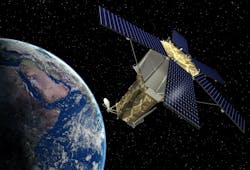KIRTLAND AIR FORCE BASE, N.M. – U.S. Air Force researchers are approaching industry for enabling technologies space-based remote sensing to improve capabilities to detect, identify, and track rapidly evolving and emerging threats from underground nuclear tests.
Officials of the Air Force Air Force Research Laboratory Space Vehicles Directorate at Kirtland Air Force Base, N.M., issued a request for information (AFRLNEMRSS0001) on Saturday for the Nuclear Explosion Monitoring (NEM) Research Scientific Solutions project.
For now, researchers want information on potential solutions for attenuation and full waveform earth models; yield estimation and discrimination; seismic source physics; and ground truth for location and characterization.
Attenuation and full waveform Earth models involves improved sensing for prediction of waveforms and amplitudes at local and regional distances. This could include local and regional attenuation and scattering models; full waveforms and finite-frequency methods; and 3D structural effects on amplitudes including blockage, scattering, focusing, and defocusing.
Related: A Boeing-Northrop team may be the only way to fix the Air Force's flawed ICBM competition
Researchers are interested in improving predictions that affect yield estimation and discrimination; as well as estimates of confidence, resolution, and variance.
Yield estimation and discrimination involves ways use space-based sensing to estimate estimating yield for seismic events recorded at local distances; resolving the tradeoff of yield versus depth through use of nonseismic data; and improving characterization of smaller events recorded at local and regional distances including determination of moment tensors and their uncertainties.
Researchers want to understand uncertainties and limitations, especially for relatively small events recorded at high frequencies; and to understand the properties of small seismic events and their seismic waveforms at local and regional distances to improve yield accuracy and discrimination confidence.
Related: Boeing to help Air Force with Minuteman III tests to keep ICBM guidance systems on target
Seismic source physics involves ways to determine depth to within tens of meters for shallow and very shallow nuclear events. Researchers want the ability to predict source generation of seismic signals, from all shallow-source types.
Also of interest are physical understanding of the dependence of seismic source generation on small shallow explosion emplacement conditions like depth, scaled depth, decoupling, material properties, pre-stress, and local structure and topography); hypothesis tests of proposed mechanisms for waveform characteristics; and investigations to distinguish between feasible source mechanisms rather than assessing the feasibility of just one mechanism.
Ground truth for location and characterization involves collecting location and source spectrum calibration events in poorly calibrated regions of interest, such as precise absolute location and depth.
Companies or universities interested should respond no later than 30 July 2020 online via SAFE at https://safe.apps.mil.
Email technical questions or concerns to the Air Force's G. Eli Baker at [email protected] or Raymond Willemann at [email protected]. Email contracting questions to Ann Peel at [email protected].
More information is online at https://beta.sam.gov/opp/6ef2faab6bd94bc5b197eee272385b46/view?keywords=AFRLNEMRSS0001&sort=-relevance&index=&is_active=true&page=1.



